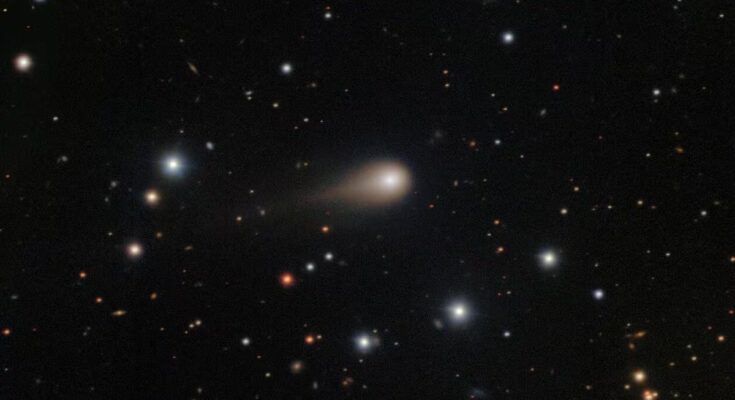Spectacular hypotheses spread more easily than true scientific facts, especially when they come from a voice of a certain prestige. This is what happened with comet 3I/ATLAS – detected last July by the Asteroid Terrestrial Impact Warning System (ATLAS) observatory in Río Hurtado (Chile) – which has been the subject of a wave of speculation on social networks since Avi Loeb, a Harvard astronomer, suggested that it could be an alien spacecraft. For experts they are nothing more than meaningless ideas. According to Michael Kueppers, astrophysicist at the European Space Agency (ESA), as seen there is nothing to indicate that it is anything other than a celestial body of interstellar origin; with unusual chemical characteristics, yes, but explainable.
“If we could really find other civilizations, comets would not be the way to do it,” explains Kueppers, who underlines that the peculiarity of 3I/ATLAS lies in its origin: “It is an object that was not formed in our solar system, but in another point of the galaxy,” he underlines. Although its exact place of origin is unknown, astronomers know that it is an interstellar traveler: a fragment of another planetary system that, after billions of years in space, is now passing through ours.
But what surprised experts most was its unique composition. Unlike most comets in the solar system, which are made mostly of water ice, other ice, and dust, 3I/ATLAS has an unusually high ratio of carbon dioxide (CO₂) to water. According to Kueppers, this feature could indicate that it formed in a colder environment than its source system, and where volatile elements could accumulate at lower temperatures. Although it could also be due to an effect of his trip.
Another distinctive feature is the abundance of metallic nickel. While the reason is not yet entirely clear, this planetary scientist points out that this discovery could provide clues to the diversity of other planetary systems. “These objects allow us to see firsthand what star systems outside our own are like,” explains Kueppers.
An unusual composition
Unlike the distant, limited images that are captured by telescopes, interstellar objects like this bring with them physical material from their very ancient worlds (3I/ATLAS is estimated to be probably 3 billion years older than the solar system). Only two other such visitors have been detected so far: 1I/’Oumuamua in 2017 and 2I/Borisov in 2019, and each has offered another piece of the puzzle of how planets and comets form around other stars.
In his most recent hypothesis, Avi Loeb – a 63-year-old Israeli-American physicist and professor at Harvard University – proposed that 3I/Atlas would perform a navigation maneuver when it reached its closest point to the center of our planetary system in late October (nearly 200 million kilometers from Earth) and, being a ship with an alien crew, would release probes to planets orbiting the Sun.
Elena Manjavacas, an astronomer at the Space Telescope Science Institute (STScI) in Maryland, dismisses any speculation linking Comet 3I/ATLAS to alien technology. For these ideas to make any sense at all, he points out, preliminary and extraordinary conditions would have to be met. “First, that life exists elsewhere in the universe; second, that it is intelligent; third, that it has developed a civilization with technological capabilities similar to those of a space agency; and, finally, that it knows about the existence of the Earth and has decided to send a ship here,” explains the Spanish scientist.
According to Manjavacas, the probability of all this happening at the same time is practically zero. On the other hand, the scientific explanation that it is an interstellar comet is much simpler and coincides with Kueppers’ words: 3I/ATLAS has unusual characteristics, but consistent with what is expected from an object traveling from cold and distant regions of the galaxy. “It is much more likely that we are seeing a particular comet, not an alien spaceship. This would, in fact, be the most unlikely possibility of all.”
Loeb has already argued in the past that the Oumuamua, with its elongated and slightly irregular shape, could be an extraterrestrial solar sail or the remains of an artifact created by an alien civilization. He based his particular hypothesis on the fact that Oumuamua, fleeting and the first of its kind, did not have the tail of a comet and that the data suggested it was unusually bright; He developed these ideas into a popular book, which was translated into several languages and criticized by the scientific community.
No defense protocol activated
The announcement of an international 3I/ATLAS observation campaign, promoted by the International Asteroid Warning Network (IAWN), coincided almost in time with astronomer Loeb’s declarations. The overlap of both pieces of news was enough to unleash a wave of bizarre theories on social media. Some publications even claimed, without any evidence, that NASA had activated an alleged planetary defense protocol against the visit of the interstellar body.
The campaign – scheduled to run between November 27 and January 27 – is a routine science initiative, designed to study objects with unusual trajectories or compositions. According to the IAWN, a network coordinated by the UN and made up of space agencies and observatories from around the world, the goal is to improve the precision of calculations on the position, speed and chemical composition of the comet. This is not a defensive maneuver, but an opportunity to deepen your knowledge of a unique visitor.
“The first thing is to listen to the scientists,” says Manjavacas. “We rely on evidence, not wishful thinking. The idea that an intelligent civilization sent a ship here may seem attractive, but it is infinitely unlikely.” Despite this, he celebrates the interest that the phenomenon arouses. “The important thing is that astronomy continues to fascinate people. Not because of aliens, but because it helps us understand our place in the universe.”



